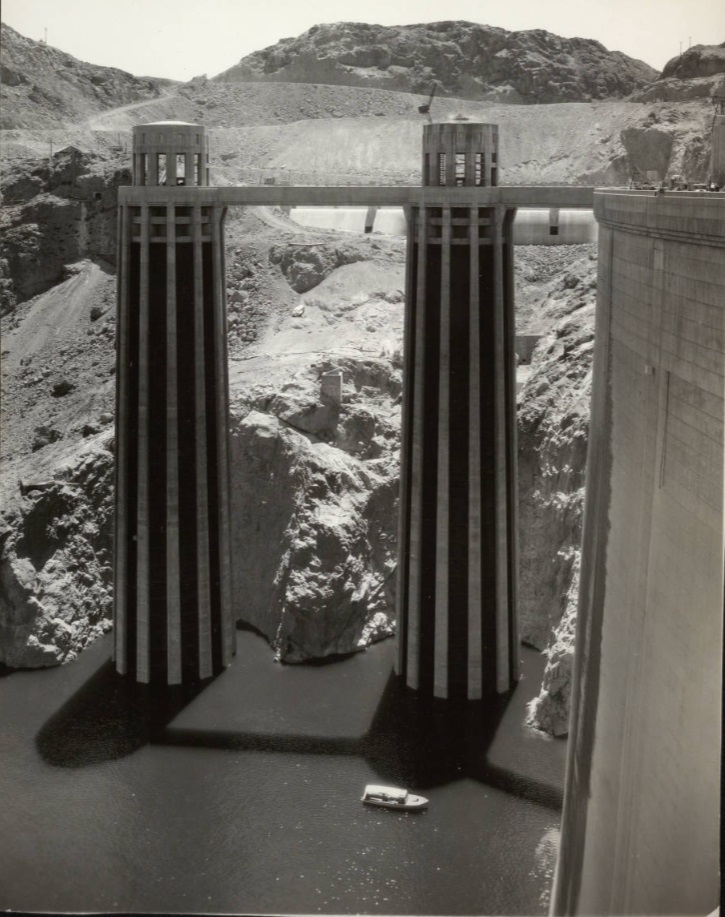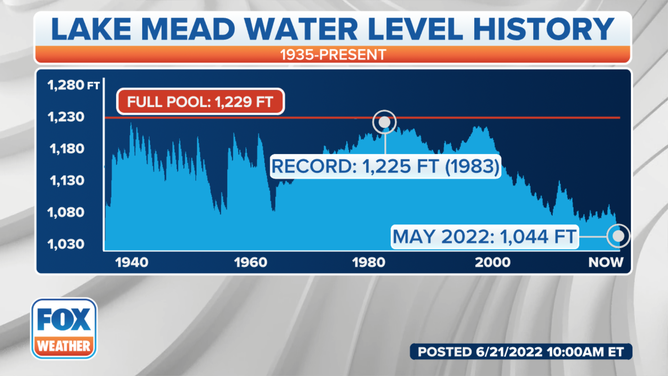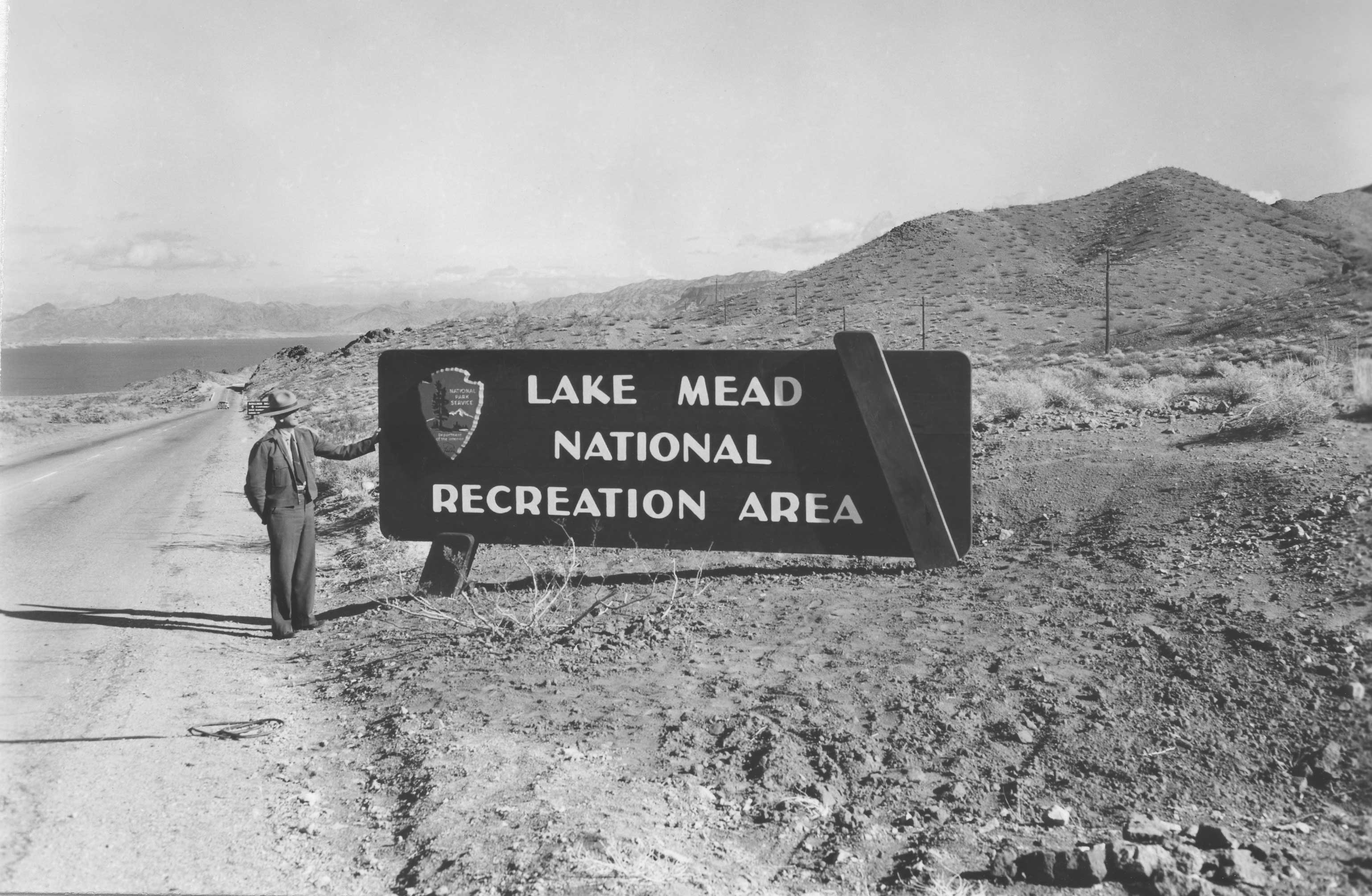At the southwestern edge of Grand Canyon National Park, on the Arizona-Nevada line, the Colorado River flows into Lake Mead, one of the largest manmade lakes in North America. How Was Lake Mead Filled?
Lake Mead was filled between 1935-1938 with:
- Snowmelt from the Rocky Mountains
- Water from upstream dams
- River diversion channels
- Tributaries along the Colorado River
- Regulated flow from Dams upstream
- River diversion channels
- Hoover Dam, facilitated, controlled & regulated the flow of water into Lake Mead
Lake Mead filled up due to the construction of the Hoover Dam on the Colorado River. Completed in 1936, it impounded water, creating the reservoir. However, drought and increased demand have led to declining water levels in recent years.
At the southwestern edge of Grand Canyon National Park, on the Arizona-Nevada line, the Colorado River flows into Lake Mead, one of the largest manmade lakes in North America. It began filling upon the completion of Hoover Dam (previously known as Boulder Dam) in 1935. These items contributed to filling Lake Mead.
At the southwestern edge of Grand Canyon National Park, on the Arizona-Nevada line, the Colorado River flows into Lake Mead, one of the largest manmade lakes in North America. It began filling upon the completion of Hoover Dam (previously known as Boulder Dam) in 1935. These items contributed to filling Lake Mead.
- Construction of the Hoover Dam on the Colorado River.
- Completion of the dam in 1936, impounding water.
- Snowmelt from the Rocky Mountains also contributes.
- The reservoir gradually filled over time, creating Lake Mead.
Once upon a time, the desert terrain of what’s now a remarkable basin near Las Vegas was destined for a transformation as epic as the stories that simmer in the Nevada heat. It all began in the suspenseful hours of the early 1930s when the ambitious Boulder Dam project (later renamed Hoover Dam), embarked on its mission to tame the wild Colorado River. As engineers and workers toiled around the clock, an epic chapter in both environmental significance and science was about to be inked. The dam’s completion irrevocably sculpted the landscape, giving birth to the vast reservoir we call Lake Mead.
Let’s journey to July of a year etched in national memory when the National Park Service would eventually play custodian to this burgeoning oasis. The gates closed, and within the grand, storied canyons, Lake Mead began to fill. Fueled by snowmelt and tributary gifts, it swelled up, painting a new blue stroke in the arid environment. Meandering along the once-raging Colorado, it stretched towards the brims of Glen Canyon and flirted with the edges of the Grand Canyon, reshaping the realm shared with an array of flora and fauna.
Tales of Lake Mead’s fill are etched in the annals of science—as the lake filled, researchers eagerly documented changes in the area’s ecosystem, uncovering numerous stories of adaptation and transformation. Lake Mead’s water level, perpetually subject to the whims of nature and human demand, is a topic of constant discussion in Las Vegas and beyond. Currently, as conservation efforts intensify and the dialogue around water usage is amplified, the question of whether Lake Mead’s water level is going up remains as pertinent as the day it was first completed.
Ultimately, the full capacity of Lake Mead, that sprawling water body held in the austere embrace of canyons, has been achieved multiple times throughout the decades, owing to the cyclical nature of water through droughts and floods. Yet today, the watchful eyes of those concerned with Lake Mead’s fate monitor its levels with bated breath, hoping for it to fill up once more, under the watchful stewardship of the National Park Service.
Lake Mead’s Inflow and Water Sources

Lake Mead primarily receives water from the Colorado River, which is its main inflow. The Colorado River originates in the Rocky Mountains and flows through several states before reaching Lake Mead. Additionally, some smaller tributaries also contribute to the inflow of water into Lake Mead, although the majority of its water comes from the Colorado River.
Nestled in the arid embrace of the Southwest, Lake Mead is a watery oasis fed by a robust network of rivers and expansive basins, its story intertwined with the famed Las Vegas. The primary architect of Lake Mead’s inflow is the robust Colorado River, a lifeline for multiple states that crave its precious drops.
This river, along with contributions from tributaries such as the Virgin and Muddy Rivers, pours into the lake—nature’s grand-scale plumbing system chaperoned by human ingenuity.
However, let’s not forget the mighty Glen Canyon, upstream, where Lake Powell acts like a sibling, sharing both resources and the spotlight in this hydrological drama.
While Lake Mead’s water level appears to flirt with gravity, waltzing up and down based on a plethora of factors, Lake Powell plays a part in this aquatic ballet, its own levels affecting Mead’s rise and ebb. The cyclical nature of drought has tightened its grip across the region, causing both lakes to display their rocky contours—a stark journal of nature’s pendulum.
The cooperative venture between these bodies of water is overseen by agencies such as the National Park Service, which guardians the natural splendor of these national treasures. Watching a video of Lake Mead’s waters is akin to peering into the fluid veins of the Southwestern United States, with every gallon painting a story of past, present, and an uncertain future.
So, is Lake Mead’s thirst being quenched enough to see its levels rise in Las Vegas’ backyard? That’s a complex question—with climate patterns rewriting scripts and water usage discussions taking center stage in state capitols.
It’s a symphony of environmental and political forces, all playing their parts in the fate of this liquid asset. However turbulent Lake Mead’s sources and states of being may be, its very existence remains a testament to nature’s and humankind’s intricate dance with the elements.
Current Status: Is Lake Mead Filling Up
Lake Mead has been experiencing historically low water levels due to persistent drought conditions and increased demand for water from the Colorado River. However, for the most current information on Lake Mead’s water levels and status, I recommend checking the latest reports from authoritative sources such as the U.S. Bureau of Reclamation or the National Park Service, as water levels can fluctuate due to various factors over time.
Amidst the stark beauty surrounding Las Vegas, Lake Mead’s vast expanse has often mirrored the fortunes of the region. The surface of this iconic lake, vital to Las Vegas’s thirst, has witnessed fluctuating levels, each foot telling a tale of changing times. Previously, we dove deep into Lake Mead’s historical narrative, discovering how this colossal basin filled up, swelling with the hopes of generations.

Intriguingly, year upon year, Lake Mead has become a focal point in discussions centered on drought and energy, acting as a barometer for environmental consciousness. As the pages of the calendar turn, the question lingers in the air – is Lake Mead filling up, or are the levels still inching down?
Currently, the fill-up story of Lake Mead isn’t one of a steadfast rise but rather a fluctuating saga dominated by drought, forcing us to review our water usage norms keenly.
Despite previous years where optimistic reports hinted at recovery, the levels at Lake Mead are not consistently on the up. The ongoing drought has firmly gripped the region, insisting we take heed of the information signaling a cry for sustainable change.
The lake, which shoulders a heavy burden of supplying energy through the Hoover Dam, has felt the impact of drought’s tightening noose.
In a year-to-year scrutiny, Lake Mead’s levels present a complex narrative. Some years witness a slight rise, providing a glimmer of hope, yet uncertainty remains as the drought persists, often pulling the levels down, as betrayed by the exposed rings on Lake Mead’s surface. The drought’s grip challenges the fill up of Lake Mead’s waters, and while certain measures have been enacted to stem the tide of decline, success wavers.
A comprehensive review of the lake’s health reveals the need for widespread policy implementation and changes in consumption patterns to fuel hopes of Lake Mead’s resurgence. Conservation efforts can contribute to elevating Lake Mead’s water levels, yet it requires collective resolve. As the drought looms, the future status of Lake Mead’s levels hinges on the battle between natural scarcity and human ingenuity. Will the lake brim again, quenching Las Vegas’s thirst? The answer remains a blend of cautious optimism stirred with realistic acknowledgment of the challenges ahead.
Hydrology News: Lake Mead’s Water Level Survey
With the sun-scoured landscape of the national park serving as a backdrop, Lake Mead’s water level has become a focal point of environmental science, drawing attention in countless journal articles and newsletters. The monthly survey of this majestic lake yields crucial data, painting a picture that’s integral to the review of regional hydrological cycles.
July’s survey often brings a tide of concern—has the water level trended up or down? Amidst the arid expanse, any sign of Lake Mead’s levels dipping sparks immediate discourse across news platforms, highlighting the gravity of the ongoing drought tormenting the American Southwest.
The Lake Mead National Park Service, stewards of this aqueous jewel, tirelessly monitor the reservoir’s pulse. Their surveys are not mere routine checks; they’re an earnest quest for understanding the lake’s current status—is Lake Mead filling up, or are we witnessing a decline that presages tougher times ahead? The park’s commitment is unwavering, with the goal to preserve Lake Mead’s splendor for future generations in the crosshairs of their conservation efforts.
Science frequently taps into the nexus of Lake Mead’s water level trends, employing them as a barometer for larger environmental shifts. The journal entries of scientists and the dispatches in environmental newsletters converge on Lake Mead’s shores, seeking to decode nature’s subtle signals. In every upsurge or descent of water levels, there’s a story—a tale of nature’s flux and humanity’s impact. It’s these fluctuations that the latest survey seeks to understand, applying rigorous methodologies to glean insights from the lake’s responsive surface.
As the summer months approach, and July’s heat approaches its zenith, all eyes are on Lake Mead. Will the lake’s water level, a life-giving oasis in a parched environment, persist or falter? It’s up to the Park Service’s meticulous survey work and the environmentalists’ keen analysis to illuminate the path ahead. With each update, the anticipation swells: will the news from Lake Mead be a harbinger of hope or a continuation of the austere narrative written by drought? The answers lie in the serene yet telling waters of Lake Mead.

Exploring NPS Data on Lake Mead’s Ecosystem
Unraveling the complex tapestry of Lake Mead’s ecosystem is a story deeply interwoven with the data meticulously gathered by the National Park Service (NPS). Celebrated as a jewel within the national park system, Lake Mead’s broad surface gleams under the Nevada sun, but it’s the science behind the scenes that truly shapes our understanding of this aquatic basin. The simmering surface betrays none of the dynamic environment below, where life thrives and adjusts to the rhythm of nature’s cadence. Exploring the park’s yearly data, we’ve learned that each year is a verse in Lake Mead’s ongoing saga.
The narratives told by the NPS encompass studies on water clarity, fish populations, and the invasive species that threaten to upset Lake Mead’s delicate equilibrium. The environment here is a confluence of storytelling and science, where researchers don their suits of curiosity to dive into the lake’s aqueous annals. It’s a grand narrative that surpasses the confines of Glen Canyon and the grandeur of the Grand Canyon, with Lake Mead playing a central role in this ecological epic.
As the NPS continues to service the science community and the park’s visitors with data, persons invested in Lake Mead’s stories can relate to the ever-changing dynamics of its ecosystem. Ecosystem data from Lake Mead are not just numbers on a page; they predict the potential surge or decline in the lake’s health and provide a compass for conservation efforts. Diving into these studies, one must acknowledge the symbiosis of environment and exploration; it’s not enough to merely hover on the surface of understanding, one must immerse oneself into the depths of data-driven discovery.
This year, as varied as any other, contributes its chapter to Lake Mead’s evolving science stories. While the ecosystem of Lake Mead endures various strains, the resilience found in the yearly NPS findings gives us a basin of hope. The crux of the current status around Lake Mead’s water levels isn’t only a barometer for Las Vegas’ thirst but a measure of nature’s profound adaptability in the face of human and climatic flux. Thus, while exploring Lake Mead and its national significance, we’re tasked with deciphering these submerged scriptures, etched not in stone but in the fluid memories of the water, preserving tales of a landscape in flux.
The Mississippi’s Role in Lake Mead’s Water Balancing Act
In the grand theatre of hydrological marvels, Lake Mead’s robust story unfolds like a science journal teeming with epic tales of nature’s balancing act. A year ago, or even further back in history, one might have pondered the role of the mighty Mississippi as a cast member in filling the colossal chalice that is Lake Mead.
Contrary to some news stories woven into the fabric of water resource discourse, the Mississippi’s contribution to Lake Mead’s water levels is more a tale of indirect influence rather than direct infusion. Lake Mead, a watershed fed by the Colorado River, stands distant from the Mississippi’s reach, physically separated by the expansive canvas of states that form the American Southwest.
Yet, in the broader picture of water allocation, river management, and interstate agreements that are as dynamic as the canyon landscapes, the Mississippi’s spirited flow undeniably plays a part in the national conversation on water policy. The science that drives the management of Lake Mead is a complex one, stitched with data, park concerns, and ecology. Sources from the National Park Service (NPS) furnish a trove of information detailing how Lake Mead’s ecosystem is a top priority, invariably linked to the river that sustains it—the Colorado, not the Mississippi.
Whether Lake Mead’s banks rise or fall in the shadow of the Las Vegas glitter is closely monitored, with review undertaken by scientists, who parse through reams of hydrology news and studies. As the United States grapples with a protracted drought, every river, including the distant Mississippi, indirectly tips the scales in the nation’s water management strategy.
For now, Lake Mead’s lifeline remains tethered to its historical inflow sources, and current states of affairs suggest this won’t change soon. With each passing year, the journal of Lake Mead continues, rich with new stories, always under the watchful eye of those who steward its precious, life-giving waters.
References:
Bureau of Reclamation– The Colorado River and Hoover Dam
FAQ’s
- When was Lake Mead filled? Lake Mead was filled between 1935 and 1938.
- What facilitated the filling of Lake Mead? Hoover Dam, constructed on the Colorado River, facilitated the filling process.
- What water sources contributed to filling Lake Mead? Snowmelt from the Rocky Mountains, water from upstream dams, river diversion channels, and tributaries all contributed to filling Lake Mead.
- Were conservation efforts involved in filling Lake Mead? Yes, conservation efforts were implemented to manage water usage during the filling process.
- How did Hoover Dam control the flow of water into Lake Mead? Hoover Dam, an engineering marvel, controlled the flow of water into Lake Mead through its mechanisms and infrastructure.
- How long did it take to fill Lake Mead? It took approximately three years, from 1935 to 1938, to fill Lake Mead to capacity.
- Was Lake Mead solely filled by natural processes? No, human intervention and engineering projects played a significant role in filling Lake Mead, including the construction of dams and diversion channels.
- Is Lake Mead still being filled today? The filling of Lake Mead primarily occurred during its initial construction period, and ongoing management ensures its water levels are maintained based on natural and human factors.


